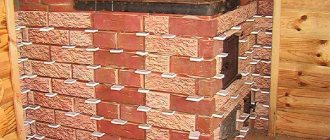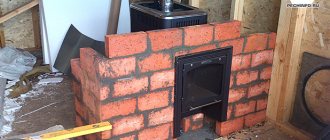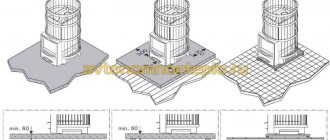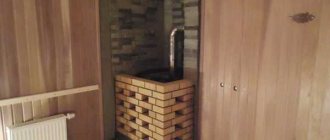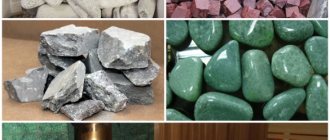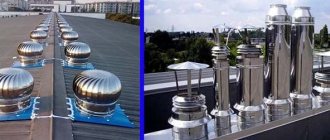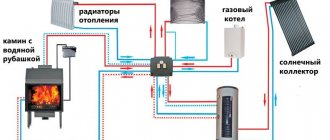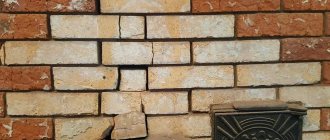Oven screen options
It is recommended to line the sauna stove with half a brick; this is the best option.
If the screen is made as thick as a brick, it will take a long time to heat up. In addition, a foundation will have to be built for such masonry. If you resort to a quarter-brick design, the bathhouse room will warm up quickly, but the radiation will be harsh. Regardless of the thickness of the masonry, the distance between the surface of the metal stove and the wall varies in the range of up to 10 cm. The screens can be a solid structure with ventilation windows, and the chimney is often also made of brick. Another solution is possible: to cover only certain elements of the furnace.
As for decor, there are many different options. The neatly executed masonry itself looks quite beautiful. The color of the red brick contributes to the design of the stove structure. At the owner's request, the bath stove can be faced with porcelain stoneware, decorative brick, natural stone, and tiles. The choice is a matter of taste and the costs planned for these purposes.
Do you need a cast iron brick?
The thermal advantages of cast iron stoves are great and undeniable, see the video below. Is it possible to improve a cast iron stove with brick lining? No way. First, cast iron is already a very good material for a stove. Lining a cast iron stove with bricks is generally the same as covering a brick stove: there will be no visible effect, but there is a lot of work and expense.
Second, cast iron is a brittle material with a large TCR. Under a brick lining, any furnace overheats beyond what is specified according to the specifications. The best structural cast iron (there is also raw cast iron for conversion into steel) will soon crack in a furnace under a brick. If a cast iron stove needs to fit into the interior, then the optimal means for this is decorative elements separate from the stove or overhead decorative elements made from cold forged parts.
Video: about choosing a stove for a bathhouse, and why cast iron ones are good
Below you can share your thoughts and results with our readers and regular visitors.
You can also ask questions to the author*, he will try to answer them.
What do they line stoves in baths with?
Today, the choice of materials for lining sauna stoves is quite wide. Natural stones include various types of natural stone with different processing options, from a rough, natural surface to a smoothly polished surface. Among the man-made ones are decorative fireplace tiles and heat-resistant solid finishing bricks, which are also made from natural materials.
Table “Natural materials for lining sauna stoves”
| Natural materials | Advantages | Flaws |
| Soapstone (soapstone) | High heat capacity, fire resistance, environmental friendliness | Loses water and acquires a porous structure. Talc forms dust deposits |
| Serpentinite (Serpentine) | Beneficial effect on the body | Low-quality material contains foreign inclusions |
| Jade | Healing properties, tonic effect | Not found |
| Slate stone "Lapland Silver" | Bactericidal, restorative properties | The shale structure of low-quality material quickly collapses |
Table “Artificial materials for lining sauna stoves”
| Man-made materials | Advantages | Flaws |
| Fireplace tiles | Variety of designs, high temperature resistance | Poorly retains heat, has more decorative than practical value |
| Heat resistant brick | High heat capacity, uniform heating, soft heat | Solid brick takes a relatively long time to warm up |
| Porcelain tiles | Heat resistance, strength, wear resistance, resistance to temperature changes | Gives off heat quickly and cools down |
When choosing which brick to line a sauna stove, many prefer heat-resistant brick with a smooth surface. Bricks with decorated surfaces of various textures and colors are also widely used.
Sauna stoves lined with brick are completely safe. The brick lining protects a person from the hot surfaces of a metal furnace. In conditions of limited space, this is one of the main components of the safe operation of a stove in a bathhouse.
Tiles
Finishing the stove in a steam room is often done with a special type of slab. They are called tiles. The technology for producing such material is inexpensive. At the same time, the appearance of the finish is spectacular. This material may have the appearance of a thick tile on the surface. However, this effect can be achieved by using tiles without a pattern.
However, much more popular are the materials of this group, which have three-dimensional patterns on the front surface. Such tiles are laid using the same technology as regular tiles. However, the thickness of the finishing layer in this case will be greater. This material is also used to finish part of the floor and wall near the stove.
A special feature of such tiles is the need for correct selection before installation. Each finishing element must be selected according to color. The tiles are compared to each other by shape and shade of glaze. If necessary, uneven edges are sanded before installation. The end result should be a smooth portal. It will become a real masterpiece.
Foundation arrangement
Now on the Internet you can find many drawings, photos, and plans for building a foundation for lining a stove in a bathhouse with bricks. What is this building?
The foundation is made in the form of a quadrangular well, the height of which is equal to the height of the furnace. To cover the metal walls, use solid or masonry with windows, through which not only fuel is thrown in, but also ventilation around the heating surface is enhanced.
According to experts, wooden floor beams can withstand up to 650-700 kg of load. Although practically, it is not recommended to give a load of more than 400 kg per 1 m². Therefore, it is advisable to further strengthen the existing frame with an iron structure from an angle (50 mm), or screw piles, provided that approximately 180-200 bricks weighing 3.5 kg each will be used for the screen.
Foundation construction algorithm
- Cut a square of a certain size in the floor (if it is already installed), dig a pit approximately 35-45 cm deep.
- Fill the bottom with coarse crushed stone, lay waterproofing, and install formwork.
- Place pieces of reinforcement in the foundation frame, apply the required amount of mastic waterproofing, and fill the structure with concrete approximately 15-20 cm above the ground.
- Bring the “pillow” to the floor level with ordinary bricks, on which the stove and lining will be placed.
- Wait about 3 weeks until the concrete shrinks, then lay thermal insulation and steel sheet (3-5 mm thick) under the stove.
Preparation of the solution
In order to properly line an iron stove in a bathhouse, it is best to use a classic clay-sand mortar. You can add a small amount (about a sixth) of grade 400 cement to it. This ingredient can only strengthen the entire structure, since the temperature of the future screen will not be high enough.
Since little clay is required, it is best to buy it at a building materials store. For rural residents, such a problem as purchasing clay should not exist.
To prepare the solution, you need to take sifted sand and mix it with clay in equal proportions. Add water gradually until you get a thick mixture that can easily slide off the trowel.
What other materials are used to line a sauna stove?
It turns out that not only bricks can be used to line sauna stoves. Granite or marble slabs are an excellent substitute. They also tolerate temperature changes well, have a large mass and high thermal conductivity. In addition, such finishing will give the bath room an unusually beautiful and unique look. Not everyone can afford such luxury, from a financial point of view. But if you have some leftovers, you can use them to build a stove partition.
True, the installation of such slabs is a little more difficult in comparison with brickwork. To ensure a beautiful appearance of the lined stove, it is necessary that the work be carried out by a specialist. At the very least, the owner needs to at least consult with such a person.
Minerite slabs are also used to construct a heat shield. With their help, the wall is mounted much easier and faster, even in comparison with masonry, and is able to withstand temperatures of 360-400⁰C. But the heat capacity of this material is low, so it can be used as a good partition that will not be able to accumulate heat.
Decorative plaster
You can decorate the stove in a bathhouse with your own hands using decorative plaster. This type of material began to be used for such purposes relatively recently. Decorative plaster in this case has certain features. It is not applied to directly finish the brick or metal surface of the stove. This material creates a barrier between the heater and the walls. At the same time, modern varieties of plaster allow you to create interesting design effects.
Plaster is used to finish walls adjacent to the stove. It is worth considering that this material is used if the heater is installed not in a steam room, but, for example, in a relaxation room. The fact is that decorative plaster has a lower moisture resistance. Therefore, it can be used in relatively dry rooms.
Decorative plaster may contain different components. This can be clay and sand, fireclay, gypsum and asbestos, lime. There are also cement-based compositions. The composition may include fiberglass, salt, and chopped straw as additives. Before installation, a fiberglass mesh is installed on the surface. Plaster is applied to it. The heat resistance and thermal conductivity of decorative plaster is high.
The process of lining a metal furnace with bricks
The entire process of lining an iron stove can be divided into several stages.
Stage 1 Foundation
The most important stage of any construction is the installation of the foundation. The durability and strength of the entire structure depends on the quality of its installation. If during the initial construction a foundation was made for the stove, then in order to cover the metal firebox you will not need to construct a new foundation. But if you are unsure of the strength of the old foundation, you need to take the time to build a new foundation, since the weight of the entire structure will increase significantly. If the total weight of the entire structure is less than 700 kg, the foundation need not be erected.
Foundation construction procedure:
- After the issue of where to install the stove has been decided, it is necessary to cut floorboards around the perimeter of the structure, taking into account that the size of the foundation should be 10–15 cm larger on each side.
- Next, you need to dig a pit up to 40 cm deep.
- Then it is necessary to build wooden formwork according to the size of the pit and the planned structure.
- The next step will be to waterproof the foundation.
- Then we pour a cushion of sand and crushed stone of the middle fraction to retain moisture.
- We fill the foundation with cement mortar and be sure to lay a layer of reinforcing mesh on top. We use a building level to check the evenness of the surface.
- Then you need to wait time for the concrete screed to completely harden.
Stage 2 Foundation construction
- After the foundation mortar has completely hardened, you need to lay out the base in one row of brickwork.
- We check again with a building level that the surface is horizontal.
- We lay a layer of roofing material to waterproof the base.
- It is necessary to lay a sheet of iron on top, which should exceed the size of the brickwork by 10 cm around the perimeter.
- Then we install a metal stove.
Stage 3 Preparation of the solution
A mixture of cement and clay will serve as an ideal mortar for lining a metal firebox with bricks. Experienced stove makers advise determining the proportion of these components by appearance. It is believed that it is necessary to take the same amount of cement and clay, while adding up to 30% river sand to the solution.
The main thing when preparing the solution is to achieve a homogeneous mass, without pebbles and lumps, reminiscent in appearance of thick sour cream. To check the quality of the prepared masonry mortar, you need to apply a little of the mixture to the brick. A high-quality mortar should not flow or slide off the brick. If the mixture is not very thick, you can add a small amount of sand.
Stage 4 Brick preparation
To complete this stage of work, it is necessary to soak a selected number of bricks for masonry in water for 12 hours. This action is required to ensure that the brick does not absorb moisture from the mortar during laying. When using old bricks, it must be cleaned of sand and old mortar.
Stage 5 How to line a metal stove
The average height of the structure will occupy 13–15 rows of masonry. Therefore, it is advisable to divide the entire work process into two stages. First you need to lay 7-8 rows and let them dry. The next day, after checking the shrinkage, we lay the remaining section of the structure.
Brick finishing process:
- You need to build a row starting from the corner of the structure, not forgetting to control the horizontal laying with a building level. Checking the correct angle should be carried out using a plumb line or a protractor.
- It is necessary to spread a reinforcing mesh on the second row to increase the strength of the structure.
- On the same row you need to start creating air gaps through which heated air will flow into the room. This operation must be repeated on rows 6 and 8. It is not advisable to make many holes. Two at the top and two at the bottom will be enough.
- The third row is laid out in the same way as the first.
- In the place where you plan to install the door for fuel and the blower, you need to lay a metal corner.
- The last row is laid out randomly.
Stage 6 Pre-firing of the furnace
An important stage is the preparation of the manufactured structure for its further operation. Do not immediately heat the oven to maximum temperature. It is necessary to perform 2-3 preliminary fires, which use a minimum amount of fuel. Such actions will allow the solution to dry thoroughly. Remember that there are a large number of schemes and methods for lining a metal stove with bricks, which you can learn about in detail on many construction Internet portals.
Finishing
The solution may take time to set, so it is better to wait 2-3 days. Finishing involves cleaning the brick from the mortar and giving it a uniform shade.
It is more convenient to remove excess solution using a drill with a brush attachment. The work is dusty, so use a respirator and goggles.
After cleaning, stains of uneven color may remain on the bricks. To even out the shade, use a solution of laundry soap and water and a hard, dense brush. After this, the brick “coat” is washed with water. The result is a beautiful shade without blemishes.
Carry out the first fire after lining slowly, allowing the brick to gradually absorb the heat.
That's probably all. I think that you will feel the comfort of a lined stove right away. The heat will become more balanced, and the heat source will delight you with a pleasant view and pleasure from independent work.
Subscribe to the blog for updates and stay up to date with all articles. Good luck and soft steam to your bathhouse! See you!
Wisdom Quote: The greatest happiness in life is the confidence that you are loved (Hugo Victor Marie).
Iron stove shielding effect
The filling screen is often advertised as the most convenient and safe for use in home baths. Most home-grown experts believe that finishing the walls and iron stove with rubble or crushed basalt best ensures heat transfer into the air and at the same time reduces the surface temperature of the heater. In reality, an iron stove, after being lined with crushed basalt or quartzite, produces very strong heat in the immediate vicinity of the stove, while at a distance of up to one and a half meters the air in the steam room does not warm up well enough.
Lining the stove in a bathhouse with brick gives a somewhat different effect:
- A thermal gap of several centimeters is created between the iron wall of the housing and the brick lining, due to which a third of the heat is transferred into the air flow flowing around the stove. Therefore, if you cover the stove in a bathhouse with your hands according to all the rules, the amount of heat produced will not decrease, but the outer brick surface will be much colder than the iron one;
- The smooth flat surface of the brick lining, like the smooth iron wall, has a concentrating effect, so instead of chaotic dispersion, radiant heat easily reaches the most remote corners of the sauna steam room.
Advice! If, after lining an iron stove with bricks, it suddenly turns out that the radiation from the iron stove causes the parts of the room that are too far away to warm up weakly, in this case the outer surface of the brick screen can be lined with heat-resistant tiles.
Any smooth plane, no matter whether it is metal or polished malachite, which is used as cladding and lining for expensive cast iron structures, gives off the bulk of the heat in the form of radiation. Therefore, the iron walls of a not very hot stove quickly dry out the floor and make the air too hot to breathe. Even at a distance of a meter and a half, the radiated heat of a stove that is not equipped with a brick screen severely burns the legs, arms and face
Even at a distance of a meter and a half, the radiated heat from a stove that is not equipped with a brick screen severely burns the legs, arms and face.
Iron furnace lining design
The weight of a steel or cast iron stove rarely exceeds 80-90 kg; another 40 to 100 kg can be provided by filling the heater. Without a brick lining, the stove structure can be freely installed on a heat-resistant, durable pallet without fear of damaging the joists or wooden floor boards.
In order to line an iron stove, you first need to decide on the basic design parameters:
- Dimensions and width of the lining. The shielding wall of the furnace can be laid out in half a brick, or in a quarter of a one and a half block. In the first case, the thickness of the lining is 12 cm, in the second it is only 8.8 cm;
- The size of the gap between the lining wall and the iron body of the furnace. Depending on the slot parameter incorporated into the design, a “cold” or “hot” brick screen is obtained;
- Choose a method to strengthen the base. It is impossible to lay the lining directly on the floor of the steam room, for reasons of the strength of the wooden base and the requirements of fire safety regulations.
In the first two rows of the lining, special air intake windows are made, through which cooler air near the floor, due to thermal suction, enters the gap between the iron wall of the stove and the brick screen, is heated and thrown out through the top layer of the heater under the ceiling of the steam room. Thus, overheating of the lining brick is eliminated, and at the same time good heat transfer of the furnace is ensured.
But you should not abuse the number of windows; it is enough to make one window in the lower tier of the lining and one in the middle part of the masonry to improve the operation of the heater. To improve heat extraction, additional steel pipes - “locomotives” - are installed from the lower rows of stone into the heater.
If you pour boiling water into the pipe, the heater practically “explodes” with a huge amount of hot steam due to the sudden evaporation of water and hot air passing through the gap between the brick lining and the iron wall of the stove.
Important! Practice shows that if you properly line a metal stove in a bathhouse, the heating time of the room remains virtually unchanged.
If a corner location is chosen for the steam room, the iron stove is tightly shielded from the walls. For normal airflow of bricks closed in the corner, a sanitary gap of 100-120 mm is left; windows for steam and air intake are not covered on this side.
Recommendations
When assembling protective screens, various difficulties may arise. To avoid them, you need to consider some recommendations:
- A gap of 3 cm must be left between the brickwork and the heating walls of the furnace. Otherwise, the brickwork will quickly crack from overheating and the pressure of the expanding metal.
- When mixing the solution, you need to choose components that are resistant to high heat.
- The protection, made of stainless steel, quickly loses its visual properties if the stove is fired very often. To preserve the appearance, you can coat metal surfaces with special paint or regularly wipe them with detergents.
Increasingly, metal stoves are being installed in modern baths. Their walls become very hot during operation, which negatively affects nearby surfaces of the room. To protect wooden walls from heat, you need to make a special screen. It can be made of metal and brick, combined with thermal insulation materials.
Plating sequence
Diagram of an iron stove lined with bricks.
Before covering the stove with bricks. you need to make sure that the floor can withstand such a load. Without a foundation, stoves weighing up to 800 kg can be installed on a wooden floor. Of course, this is provided that the beams and joists are in good condition. A sheet of steel is placed on the floor, a layer of brick is placed on it, and then a stove is installed. If the floor is wooden, then a sheet of asbestos must also be placed under the metal. The steel sheet lining should protrude 30-40 cm in front of the front wall of the stove to prevent hot coals from falling onto the unprotected floor. Metal sheets with an asbestos cement backing also need to be attached to the walls of the room located next to the stove. It is necessary to take into account that a gap must be left between the stove lining and the wall of the room.
There must be a gap of 30-50 mm between the metal wall of the stove and the masonry. This must be done because metal and brick have different temperature coefficients of linear expansion. When heated, metal expands much more than brick, so if you place a potbelly stove closely, without a gap, the stove may collapse. Free space between the metal wall and the brick is also necessary for air convection.
As a rule, they line the stove with 1/2 brick. It makes no sense to make the wall thicker, since it will take too much time and fuel to warm up thick brickwork. Before you start covering the potbelly stove, you need to make markings, taking into account the gap. Mark the outer contour of the furnace. The first row is made continuous. You should try to make the thickness of the mortar between the bricks no more than 0.5 cm. In the second row, 1-2 holes are made on each side of the stove, depending on the size of the stove. The length of the holes is 1/2 of a brick. All subsequent rows are continuous, like the first row.
The front wall of the stove on the firebox side must be lined with ease of use in mind - the door must open and close freely. Here you can show your imagination and perform figured masonry. At the top of the opening above the door you need to lay a metal corner on which the top rows of bricks are laid. The upper part of the stove can be covered at your discretion, since technically it does not play a significant role, performing mainly a decorative function. The top of the oven can be made in the form of a vault or made flat.
After the lining is completed, the mortar in the joints should dry. This will take 1-2 days. After this, the surface of the masonry must be cleaned from excess mortar using a drill with a brush attachment. Then the masonry is washed with a soapy solution and a brush with stiff bristles.
Nowadays there is a large selection of metal stoves of various designs and price categories on sale. Metal stoves are used for heating private houses, temporary structures, at construction sites for heating workers, security guards and other purposes. The use of metal stoves in home baths and saunas is also increasingly gaining popularity, although in this case a brick stove is considered more traditional, but it cannot always be used for a number of reasons. The main advantages of metal stoves are their compactness (since not every room can install a brick oven), ease of installation, fast heating. The main disadvantage is that after stopping the fire, it cools down quite quickly. This drawback can be eliminated by lining a metal stove with bricks. This will greatly extend the heat transfer without increasing the size of the stove too much. If you made a metal stove yourself, then by lining such a stove with brick, you will give your stove a decorative look.
Having basic construction skills, you will be able to line an iron stove with bricks yourself; for this you will need the following materials and tools.
Nuances you need to know when starting cladding
In general, laying bricks for cladding in terms of technology is no different from laying stove walls.
However, when deciding to line a cast-iron or iron stove with bricks, pay attention to the important points listed below
Every 4th row of facing masonry is recommended to be reinforced with wire or steel strip.
The firebox opening (including the opening of the remote firebox) is reinforced with a metal corner. During the cladding process with your own hands, you will need a heat insulator. You can use asbestos or basalt cardboard as it. Review all purchased bricks for defects (chips, cracks, etc. ). Take the time to lay out the material on the floor, adjusting brick to brick so that the pins touch with the smallest possible gap.
Follow the same order when laying bricks on the mortar. The mortar for masonry should match the chosen type of brick. However, you won’t have to rack your brains here. Usually, when purchasing building materials, you will immediately be offered a dry mixture, which you only need to dilute with water according to the instructions. Watch the thickness of the seams, do not make them too wide. The thinner the seams, the better thermal conductivity the cladding will have. Be sure to check the verticality of the corners with a plumb line, as well as the horizontality of the rows with a level.
Shielding of sauna stoves
Having understood how to line an iron stove in a bathhouse with brick, you can begin to study other methods of shielding metal stoves. The fact is that it is not always possible to line a metal furnace, so you have to find other ways to ensure fire safety.
Typically, protecting the walls of a room from fire when a stove is installed in it is carried out using special screens. In this case, in any case, the stove itself must be placed from the wall at a distance of at least 1 m for a brick wall, and 0.7 m for a lined metal wall. The use of protective screens can reduce this distance to 0.3 meters.
Metal screens are considered the most common. They are usually made of steel or cast iron. Such screens do not burn through and protect wooden walls well from overheating and possible fire. Such screens can be easily mounted directly on the wall or to the floor using metal legs.
Screens can be used to cover the entire oven. But at the same time, purely aesthetic goals will be achieved, but the issue of improving the heat distribution system indoors will not be resolved. To do this you will have to use other methods.
There is also the option of arranging a protective screen made of brick. In this case, the oven is not completely lined, but a protective wall is laid out only on one side. Its main purpose is to protect the wooden wall from fire due to overheating. Sometimes, for this purpose, a protective screen is erected to the ceiling.
The third option for arranging protective screens for furnaces is the use of various non-combustible materials. Usually this:
- basalt wool;
- basalt cardboard;
- asbestos cardboard;
- mineralite
Such materials are installed in place in the following order: ventilation gap, non-flammable insulation, sheet of stainless steel or other metal. To attach such a “sandwich” to the wall, you must use special metal bushings. The fact is that they do not heat up and at the same time allow the formation of a sufficient ventilation gap.
What to pay attention to during installation
It is necessary to remove a pipe in a bath taking into account a number of its features (material, design). The installation is influenced by sanitary and environmental standards, the material from which the bathhouse was built. Do not forget that traditionally this is a tree.
Compliance with certain rules and regulations will make the structure reliable and safe:
- Any one must be insulated with environmentally friendly and non-flammable material: expanded clay, asbestos, stone wool.
- Thermal insulation of the place where the chimney passes is necessary only with foil material. It is often confused with materials covered with Dacron foil, but it is highly flammable and melts at temperatures above 300 °C.
- The chimney is installed so that the structure does not touch any wooden elements: floor beams, roof, walls. To insulate the joints, they are sheathed with metal sheets. The outlet area can only be insulated with non-flammable mineral wool or expanded clay mound.
- Inside the ceilings you need to install a special iron box, into which the structure is placed and covered with expanded clay. There is no need to make a box for the sandwich.
- On top, to avoid contact with the roof, a casing of metal sheets is made around it.
- All joints and seams can be sealed with special iron foil tape or foil.
Carrying out masonry
Covering the oven
How to properly line a sauna iron stove with bricks? When covering a stove in a steam room, you should assume that the masonry is made in half a brick. To ensure air access, at least two holes the size of half a brick must remain in the second row of laid bricks. When carrying out the work, you should also remember that it is necessary to leave holes both for storing firewood and for accessing the ash pit. The size of the holes must ensure that the corresponding doors open freely.
Having brought the masonry to the upper edge of the door, corners should be installed on the outside and inside. They will provide support for the next brick rows and ensure uniform distribution of the load of the bricks laid on top.
During work, you can periodically leave holes to allow air circulation.
In its upper part, the masonry can remain open. In this case, the last row is laid out according to the level of the water tank. It is possible to construct a vault and cover a metal pipe with bricks only for purely decorative purposes. The work of arranging the masonry is much easier to complete if the masonry on top does not overlap
This is especially important for those who have to do such work for the first time.
Decorative plaster
Plaster for stoves began to be used relatively recently. Indeed, a good stove does not need to be plastered. It is made either of high-quality brick, which in itself looks decorative, or of metal, which also does not need plaster.
In this case, we are not talking about plastering the stove itself, but about creating a protective separating layer of plaster between the walls and the stove. Plaster is quite suitable here.
Finishing the walls in the bathhouse around the stove with decorative plaster is especially often done when the stove is not placed in a steam room.
In this case, the requirements for moisture resistance are much lower.
Masonry mortar
The inner surface of the brick lining of the stove can heat up to 350-400 degrees, so a regular cement-sand masonry mortar is only suitable for the screen of a sauna stove, spaced at least 7-8 cm from its body. In other cases, you need to use a clay-cement mortar, because stove clay is fragile and hygroscopic.
To prepare a solution for lining a stove with bricks, you must first sift the dry clay through a sieve with a mesh size of 1.5 mm. Next, the fat content of the clay solution is adjusted:
- A test portion of clay is mixed with mountain or ravine sand of fraction up to 1 mm in a 1:1 ratio by volume.
- Cover with water and knead until the dough becomes thick.
- Roll into a rope (sausage) approx. thick. 2 cm and length approx. 30 cm.
- Allow to dry not in direct light for 1-3 hours at a temperature of 30-15 degrees, respectively.
- Bend the tourniquet into a ring.
- If the rope is deeply cracked in several places or broken, the initial (base) solution is thin, you need to add more clay.
- The tourniquet bent smoothly or only the dried crust cracked - the base solution is greasy, you need to add more sand.
- The tourniquet cracked more or less evenly along its length to no more than 1/4 of the thickness - the fat content of the base solution is optimal.
A test portion of the working solution is prepared by replacing 1/8-1/3 of the clay with cement from M400; Usually they give 1/5 to start with. The dry mixture is gradually mixed with water, kneading until the cream becomes thick. Then check the solution for fluidity: dip a clean trowel into it and remove it, holding the nose down. There are 3 possible cases here:
- The solution drains, leaving stains on the trowel or completely exposing the metal - there is a lot of water;
- The solution drains, leaving a lumpy layer with lumps on the trowel - there is not enough water;
- The solution drains, leaving a thin, even layer of water in moderation.
Now you need to check the solution for stickiness (adhesion); This is important for laying half/quarter bricks. Take a brick, dip it in water, and apply a 3-5 mm layer of solution onto its bed with a trowel.
Immediately take a dry brick and place it on a layer of solution, without pressing down, immediately lift it. The mortar should not stretch behind the dry brick; sticking of several small, match-head-sized lumps is acceptable. If the mortar follows the dry brick, the proportion of clay in the base mortar must be reduced, respectively. increase the proportion of cement.
Next, the dry brick is again placed on the mortar, tapped with the handle of a trowel and left for 5-6 minutes. They try to lift it, the wet brick should rise with it. If it remains lying or gradually comes off while hanging, you need to add more clay in the base solution and, accordingly. less cement.
Brick screen design
A steel or cast iron sauna stove can be lined in several ways:
- Build a continuous partition up to the top edge of the stove, leaving several openings in the lower rows of bricks for air passage.
- Lay out the screen of the same height, but with numerous openings, as shown in the photo.
- Cover the stove completely with bricks on all sides and build a chimney.
The first option is the most common. The solid design allows you to accumulate maximum heat and serves as good protection for people steaming, because the surfaces of the iron walls heat up to a temperature of 700 ° C when the stove in the bathhouse reaches operating mode. This is fraught with burns from infrared radiation.
The lining with openings has more of a decorative function than an accumulating or protective one. Although such a partition saves some amount of heat. It is advisable to build in a small steam room, where there is a danger of accidentally touching the hot surface of the heater.
The latter option is suitable for homemade stoves welded from metal specifically for the bathhouse. Brickwork hides the not always presentable appearance of the product from all sides. The disadvantage of this method is the large amount of bricks and the complexity of execution, which requires skills in the stove business. The technique is described in more detail in the following video:
Insulation methods
There are several techniques that allow you to reliably insulate wooden structures from the heat of the stove. Some of them involve a fairly large amount of work, while others are much simpler.
- Creating a protective box from brick or stone.
- Installation of a special industrially manufactured screen.
- Creating a protective structure with your own hands from non-combustible materials.
The construction of a box made of brick or stone will require the most time - it will be necessary to lay out several walls that will protect the wood from heat. In addition, this protection option requires a gap between the wood and the brickwork from 5 to 15 centimeters. There should be about 10 centimeters between the casing being built and the walls of the stove. All this eats up useful space and requires some mason skills to work on.
Factory screens are installed quite simply and are not that expensive. They could be an ideal solution if they did not require even larger technological gaps between different surfaces. Therefore, such finishing of the wall near the stove is possible only in a fairly spacious bathhouse. If you need to save space, it is better to look for another solution that allows you to reduce all the gaps from wooden partitions.
The third option allows you to reduce distances to 15 centimeters, which is already more acceptable
At the same time, this method allows you to create the most beautiful design, which is important. However, there will be a lot of work and the costs in this option may be much higher than in the previous ones. In addition, this insulation method requires a more detailed consideration due to the features of the assembled structure
In addition, this insulation method requires a more detailed consideration due to the characteristics of the assembled structure.
Kinds
Portals for furnace equipment in a bathhouse are classified depending on various factors. By form:
- arched structures;
- rectangular or square portals.
According to the material:
Brick, natural or artificial stone. Most often, these materials are used for decorative framing. They are suitable for lovers of the classics. They look impressive in baths made of wood. The best option is red brick or clinker. Often the metal elements of stoves are decorated using artificial or natural stone. Tree. Since this material is flammable, it cannot be used as a base for a portal. Wood is suitable only for decorative purposes. At the same time, it must be impregnated with a protective composition against fire. Ceramic tile. A finishing material, the appearance of which is chosen depending on the wishes of the owner. Experienced builders do not recommend using large tiles. Drywall, metal. Sometimes the decorative design of furnace equipment is made from these materials
It is important to choose drywall that is resistant to high temperatures. The frame is made of metal.
Brick selection
Not every material is suitable for lining a stove. There are a number of requirements for brick. The stove heats up to high temperatures, which means the brick must withstand such temperatures.
Fireclay brick, heat-resistant alumina brick, clinker brick or fire-resistant red brick are suitable. These species can withstand high temperatures, are full-bodied, and will last you for many years.
Fireclay bricks can be used even at temperatures above 1000 degrees. It is made on the basis of clay by firing and with the addition of fireclay chips. Fireclay brick, despite its light weight, is dense. And due to its light weight, it conducts heat faster than others.
But the material is very expensive. Therefore, in order to save money, it is used for partial lining: it is used directly at the fire source. Red refractory brick will cost several times less, as a result of which it is used much more often.
It is also made from clay. It can be used for a complete covering or only at the site of the fire. Red brick accumulates heat and releases it. Alumina is in demand because of its price and good characteristics.
You can also look at the brick in section: it should be free of stains and well painted. Be sure to ask for quality certificates; if there are none, do not purchase anything from this store.
Burning
This is the easiest way when you need to remove insulation to transfer wires. This is also the most effective method if the inside is made of polyvinyl chloride. When a small area needs to be treated, use a lighter or soldering iron. Under thermal influence, the winding softens and it simply comes off the wire. If the winding thickness is small, this option is the most effective.
There is one drawback - it has a smell. Therefore, work must be carried out in a room with access to fresh air. Toxic emissions during the firing process negatively affect the body.

